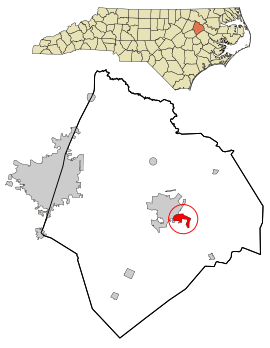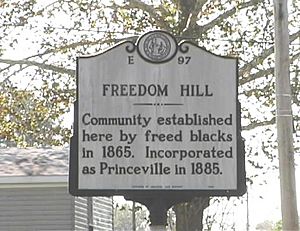Princeville, North Carolina facts for kids
Quick facts for kids
Princeville, North Carolina
|
||
|---|---|---|
|
||

Location in Edgecombe County and the state of North Carolina.
|
||
| Country | United States | |
| State | North Carolina | |
| County | Edgecombe | |
| Founded | 1865 | |
| Incorporated | 1885 | |
| Named for | Turner Prince | |
| Area | ||
| • Total | 1.52 sq mi (3.94 km2) | |
| • Land | 1.51 sq mi (3.91 km2) | |
| • Water | 0.01 sq mi (0.03 km2) | |
| Elevation | 36 ft (11 m) | |
| Population
(2020)
|
||
| • Total | 1,254 | |
| • Density | 830.46/sq mi (320.65/km2) | |
| Time zone | UTC-5 (Eastern (EST)) | |
| • Summer (DST) | UTC-4 (EDT) | |
| ZIP code |
27886
|
|
| Area code(s) | 252 | |
| FIPS code | 37-53840 | |
| GNIS feature ID | 2407162 | |
Princeville is a town in Edgecombe County, North Carolina. It was founded by formerly enslaved people after the Civil War ended. The town began in 1865 and was first called Freedom Hill.
In 1885, Freedom Hill officially became a town called Princeville. It was the first African American community in the United States to be independently governed. This means the people living there could elect their own leaders.
Princeville is near Rocky Mount, North Carolina. It sits across the Tar River from Tarboro. In 2020, about 1,254 people lived in Princeville.
Contents
History of Princeville
Founding by Freed Slaves
After the American Civil War ended, many formerly enslaved African Americans looked for a safe place to live. They found a temporary camp near the Tar River, south of Tarboro, North Carolina. With help from the Freedmen's Bureau, which helped formerly enslaved people, they built their own settlement.
They named their new home Freedom Hill. This name came from a small hill where a Union soldier first announced the Emancipation Proclamation. This important document declared many enslaved people free. The land they settled on was often flooded, but the original owners did not try to remove them.
Early Challenges and Growth
Life was hard in Freedom Hill at first. The community faced a lot of poverty and received little help. However, during the Reconstruction era (the time after the Civil War), some land was sold to the freed people at low prices. More homes were built near the Tar River bridge.
Unlike many other towns started by freed slaves, most people in Freedom Hill did not work as farmers. In 1880, most residents worked in different jobs. They were day laborers, laundresses, carpenters, and blacksmiths. This showed a diverse workforce.
Becoming an Incorporated Town
Over time, both Black and white residents in the area agreed that the community should become an official town. The Black residents wanted to govern themselves and have a say in local politics. White residents wanted Black workers nearby but in their own community.
In February 1885, the North Carolina General Assembly officially made Freedom Hill a town. They named it Princeville, after a local carpenter named Turner Prince. The town was then able to elect its own government. After this, more businesses started in Princeville.
Challenges and Resilience
Princeville faced many difficulties during the Jim Crow era. These were laws that enforced racial segregation and discrimination. White business owners tried to take control of the town, but they were not successful.
After World War I, many people moved away from Princeville. They went to northern cities as part of the Great Migration. They were looking for better jobs and to escape unfair treatment.
Princeville has also faced many challenges because it is in a low area near the Tar River. This means it often floods. In 1967, a levee (a wall to prevent flooding) was built to protect the town.
However, in September 1999, Hurricane Floyd caused severe flooding. The water was so high it almost reached the rooftops. The U.S. Federal Emergency Management Agency (FEMA) offered to buy all the homes, but the town leaders said no. They wanted to rebuild.
In October 2016, Hurricane Matthew also caused terrible flooding. This again left residents with a tough choice: rebuild or move. Even with these challenges, Princeville has continued to work towards protecting its future. In 2020, money was set aside to build a stronger levee system.
Princeville's Historical Sites
As the first town chartered by Black people in the United States, Princeville has many important historical places.
Students from North Carolina State University even created a mobile museum in 1999. This museum showed off the town's special history.
Some historic buildings you can find in Princeville include:
- The Abraham Wooten House
- The Mount Zion Primitive Baptist Church
- The Princeville School, which was added to the National Register of Historic Places in 2001.
Geography of Princeville
Princeville covers an area of about 3.95 square kilometers (1.52 square miles). Most of this area is land, with a small part being water.
Population Changes Over Time
| Historical population | |||
|---|---|---|---|
| Census | Pop. | %± | |
| 1890 | 428 | — | |
| 1900 | 552 | 29.0% | |
| 1910 | 627 | 13.6% | |
| 1920 | 562 | −10.4% | |
| 1930 | 614 | 9.3% | |
| 1940 | 818 | 33.2% | |
| 1950 | 919 | 12.3% | |
| 1960 | 797 | −13.3% | |
| 1970 | 654 | −17.9% | |
| 1980 | 1,508 | 130.6% | |
| 1990 | 1,652 | 9.5% | |
| 2000 | 940 | −43.1% | |
| 2010 | 2,082 | 121.5% | |
| 2020 | 1,254 | −39.8% | |
| U.S. Decennial Census | |||
Who Lives in Princeville?
| Race | Number | Percentage |
|---|---|---|
| White (non-Hispanic) | 37 | 2.95% |
| Black or African American (non-Hispanic) | 1,162 | 92.66% |
| Asian | 1 | 0.08% |
| Other/Mixed | 36 | 2.87% |
| Hispanic or Latino | 18 | 1.44% |
According to the 2020 United States census, there were 1,254 people living in Princeville. There were 789 households and 556 families in the town.
See also
 In Spanish: Princeville (Carolina del Norte) para niños
In Spanish: Princeville (Carolina del Norte) para niños



